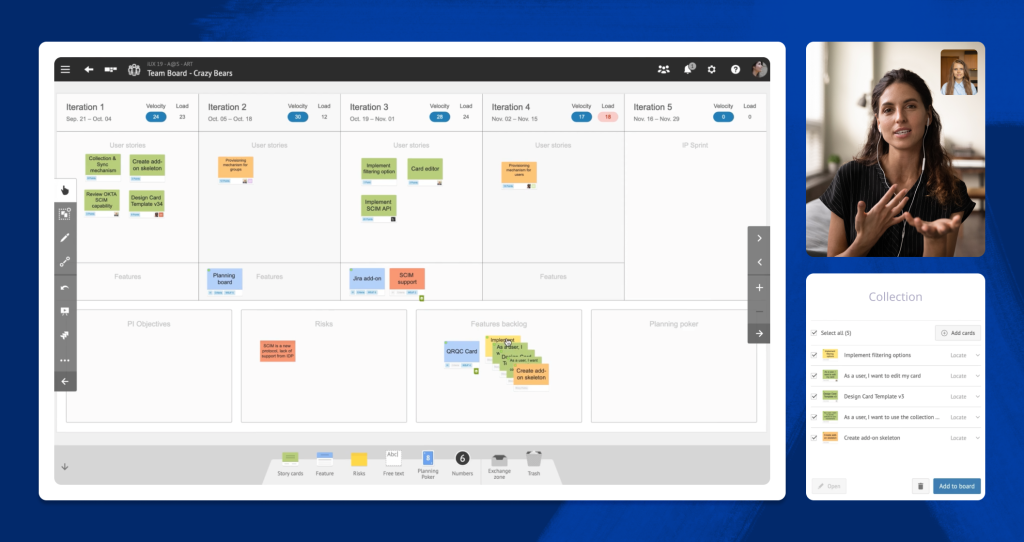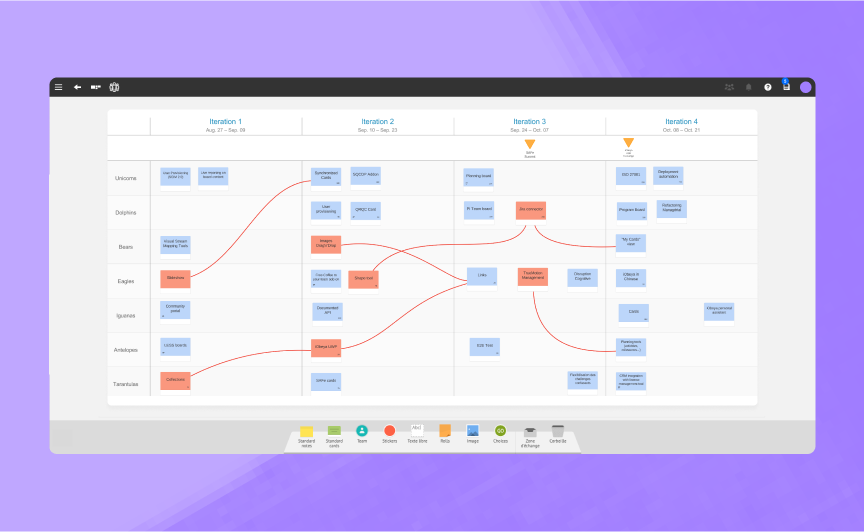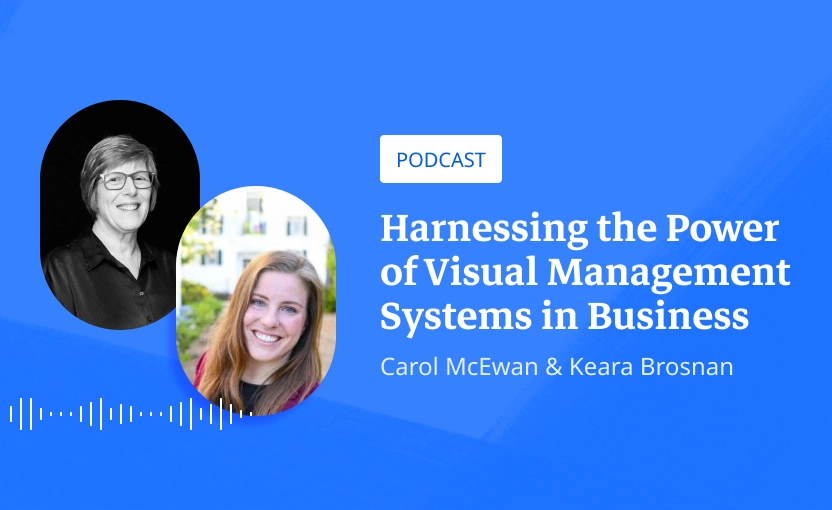Hey, let’s start your
iObeya journey!
From the garage to the campus, high-functioning organizations have intentional processes and systems that enable them to function like a small and nimble team. Visual management systems equip the organization with the ability to implement these processes and systems, thus unlocking new capabilities to scale effectively.
The Way Global Businesses Collaborate and Manage Change
Every business starts somewhere. Many were born in a garage with a vision and a few eager entrepreneurs. In the garage environment, communication is easy, decisions take minutes instead of days, and change is achievable. The team feels aligned, valued, and is willing to jump in anywhere for anything. They have to! More importantly, they want to! The team is invested in achieving the organization’s goals.
In a new business, receiving and applying feedback from early adopters is simple. The product improves and soon the phone is ringing endlessly with prospects.It is inevitable that the organization grows, more or less, in sync with its customer base. What started as a few heads in the garage is now expanding to a small office or warehouse to fulfill the growing list of customer needs. As the footprint grows, so does the complexity of the business’s value delivery system. This complexity trickles down into communications, and soon decisions grind to a halt. With growth comes the need to redefine everything!
In 500 BC, Heraclitus claimed, “Change is the only constant in life.” Benjamin Franklin expanded upon this: “One’s ability to adapt to those changes will determine your success in life.” Sears is a prime example. Since its founding in 1892, Sears boomed, boomed, and boomed again… but couldn’t adapt to advancements throughout the .com era, fell behind fast-moving competitors, and was stymied by, above all, a lack of innovation. An organization’s capacity to adapt to change plays a pivotal role in determining its trajectory.
Over the years, we’ve seen many ways of working come into play. On-shore, off-shore, centralized, decentralized, waterfall, Lean, and Agile. Much like the weather in Colorado, wait ten minutes and it will change. Organizations go through a “paradigm shift” about every seven years.,often called the “Pendulum Swing,” whether that shift was truly needed or not.
Today, we are still learning new ways of working to adapt to this ever-changing and complex world we live in.
Team Culture Rooted in Lean and Agile practices
Lean and Agile transformations are among the most recognized throughout every industry. The implementation of associated principles, practices, and patterns have proven effective at incrementally improving the speed, quality, and safety of delivering value. Similar to the small garage-based startup team, adopting Lean and Agile principles leads to simplified, almost painless, communication and decision-making within the team. A team culture rooted in Agile and Lean will develop positive working relationships, natural alignment to the vision, and reduce burnout.
I remember all too well; I was catching up with a friend excited to tell him all about my work at Scrum Alliance when he stopped me dead in my tracks! He said, “I hate that Agile stuff!” Of course, I asked why. He said, “Because our software teams are ‘Doing Scrum’ and we can’t keep up with them. It doesn’t help if they are delivering software faster than we can market it and get it out the door!” That’s when I said, “If you can’t beat ‘em, join ‘em.” We discussed how they could work with the software teams and learn to collaborate and align around what was important. They hadn’t considered that before and it wasn’t long after that when he called me and said “I love this Agile stuff, we make our work visible and communicate across teams, collaborate, and make better decisions quicker.” I couldn’t have been more excited for my friend’s newfound enthusiasm for his work.
It wasn’t until recently that organizations recognized that these principles, practices, and patterns might be effective beyond the shop floor or software teams and have started to scale them throughout their organization. Some organizations have seen exponential improvements… and some have not.
The Business Agility Institute has defined Business Agility as “a set of organizational capabilities, behaviors, and ways of working that affords your business the freedom, flexibility, and resilience to achieve its purpose. No matter what the future brings.” Say it louder for those in the back.
Stable Systems Enable Business Agility
“Float like a butterfly, sting like a bee. The hands can’t hit what the eyes can’t see.”
Muhammad Ali had the ability to move fast—with speed, nimbleness, and responsiveness, to pivot and move. He developed this unique combination purposefully and intentionally. For Ali, it was about visualizing the fight, enabling rapid detection of features, patterns, and anomalies. This kind of agility didn’t come easy to Ali. He developed a system—a set of rituals he followed. He worked out six days a week and would train anywhere between two to fourteen weeks ahead of a fight. Apparently, he hated every minute of training. He said, “Don’t quit, suffer now and live the rest of your life as a champion.” Ali relied on calisthenic training more than weightlifting. Jumping rope was a staple part of his workout, with around 10-20 dedicated minutes per session. Many considered him to be one of the best jump-ropers in boxing and believed that it aided his quickness in the ring. Ali developed a system to execute his strategy that led him to a 92% win rate across his 61 fights.
Organizations must do the same. The difference is they are not a one-man band training for a 12-round fight. It’s day-in, day-out constant execution that requires a unique combination of skills, processes, technologies, and human abilities to achieve the goals you have set for yourself. To survive and thrive in today’s business landscape, organizations must be ready to come out of their corners swinging, just like Ali did. They need to be able to visualize the work, enable rapid detection of features, patterns, and anomalies, and move fast—with speed, nimbleness, and responsiveness.
Leadership Behaviors Which Foster Business Agility
A ship doesn’t navigate the globe and command the crew by itself. Organizational leaders cast the vision, set the mission, and define the strategy. In my experience, I’ve seen too many business leaders abandon these five fundamental principles as their organization scales:,
1st principle: Ensure organizational and team alignment — Aligned teams share the vision, understand goals, and leverage individual strengths. They are more engaged, more productive, and much happier employees.
2nd principle: Cultivate people-centric cultures — When leaders create cultures where employees feel valued, trusted, and supported to achieve their potential, employees tend to share their ideas for improvement more openly. This translates into higher productivity, innovation, better customer service, and stronger business results.
3rd principle: Create a learning organization — Employee knowledge and experience will enable new innovations and improve culture.
4th principle: Visualize the System — While visual management practices have been used at the team level for years, it’s time to bring this to the executive level. When you visualize the work throughout the entire system, you increase trust and transparency, improve collaboration, and increase the ability to respond quickly.
5th principle: Leverage technology to enable and sustain these behaviors – As a leader, it is imperative that you support the behaviors and ways of working necessary to develop the capabilities that aid in your organization’s agility.
The Visual Management System
Dr. Edward Deming (1900—1993) is widely acknowledged as the leading management thinker in the field of quality and is recognized for his work in hastening Japan’s recovery.
The Red Bead Experiment is an interactive teaching tool designed in 1982 by Dr. Deming. Using statistical theory, the experiment demonstrates how “willing workers” have less control over their performance than the actual systems they’re working within. “85% of the reasons for failure are deficiencies in the systems and processes rather than the employee. The role of management is to change the process rather than badgering individuals to do better.” Additionally, Dr. Deming found that a bad system will beat a good person every time.
Organizations, where collaboration and teamwork are not a high priority, are rooted in toxic systems that contribute to staff burnout and the feeling that putting in their best effort is fruitless.
I have worked in organizations where collaboration and teamwork were not a high priority and the systems made it very difficult to feel like you had done your best work. I have also worked in organizations that took time to develop systems that supported the practices of visualizing work across teams, and anyone internal was welcome to have a look. They were designed to promote transparency and provide insights into the work that was being done via methods that required little to no time to understand and would give everyone a clear picture of the day-to-day operations. These activities were critical to seeing the “Big Picture” across the project teams and highlighting any problems that might require immediate action. I thought everyone worked this way!
Today, we would refer to this as a Visual Management System. It was the team’s responsibility to maintain the system. We didn’t always like the work involved in maintaining it, but just like Ali said, “Don’t quit, suffer now and live the rest of your life as a champion.” We knew we couldn’t quit; it was part of the system to ensure the successful completion of our project. We believed it aided us in our ability to finish ahead of schedule and under budget, and to win as a team.
Now, more than ever, it is important to have an enterprise visual management system, to create the stability that enables agility. A system that supports all ways of working, regardless of the development framework and no matter where the work is done. A foundation, a place where you can align on the vision, mission, values, goals, and objectives and have conversations across the organization at every level. A system that enables Business Agility and supports the capabilities, behaviors, and ways of working necessary to scale to any size of an organization, and still feel like you are a member of a start-up team in someone’s garage, where it is easy to communicate, make decisions, and adapt to change. Where everyone is aligned, feels valued, and is willing to jump in and do whatever job needs to be done. Where the most important things are important to everyone, and everyone is invested in achieving the organization’s goals.
Take time to develop Simple Ubiquitous Collaborative Communication Enterprise Scalable Systems that will set you up for SUCCESS now, and in the future. To explore how to set your enterprise up for success, contact iObeya.






